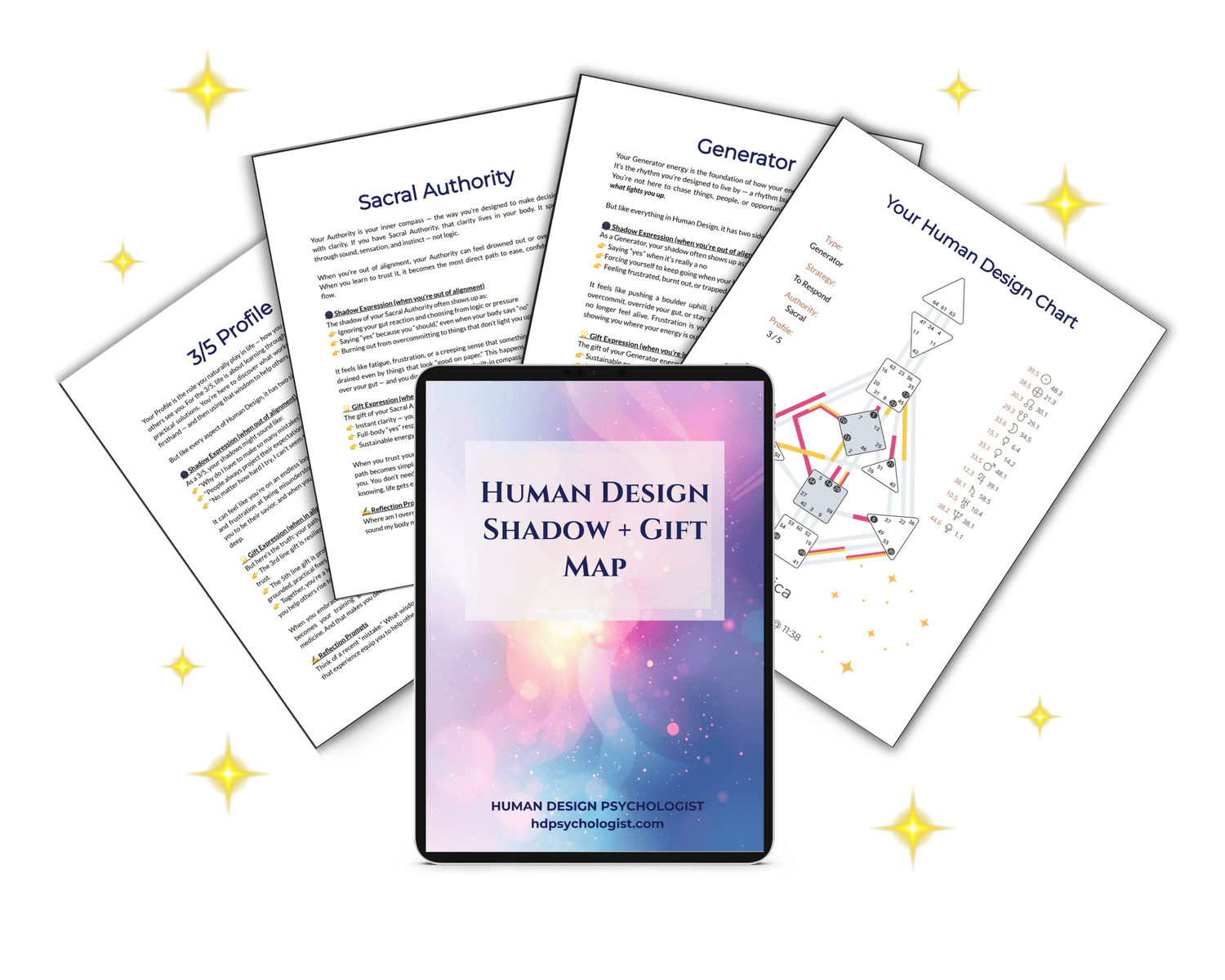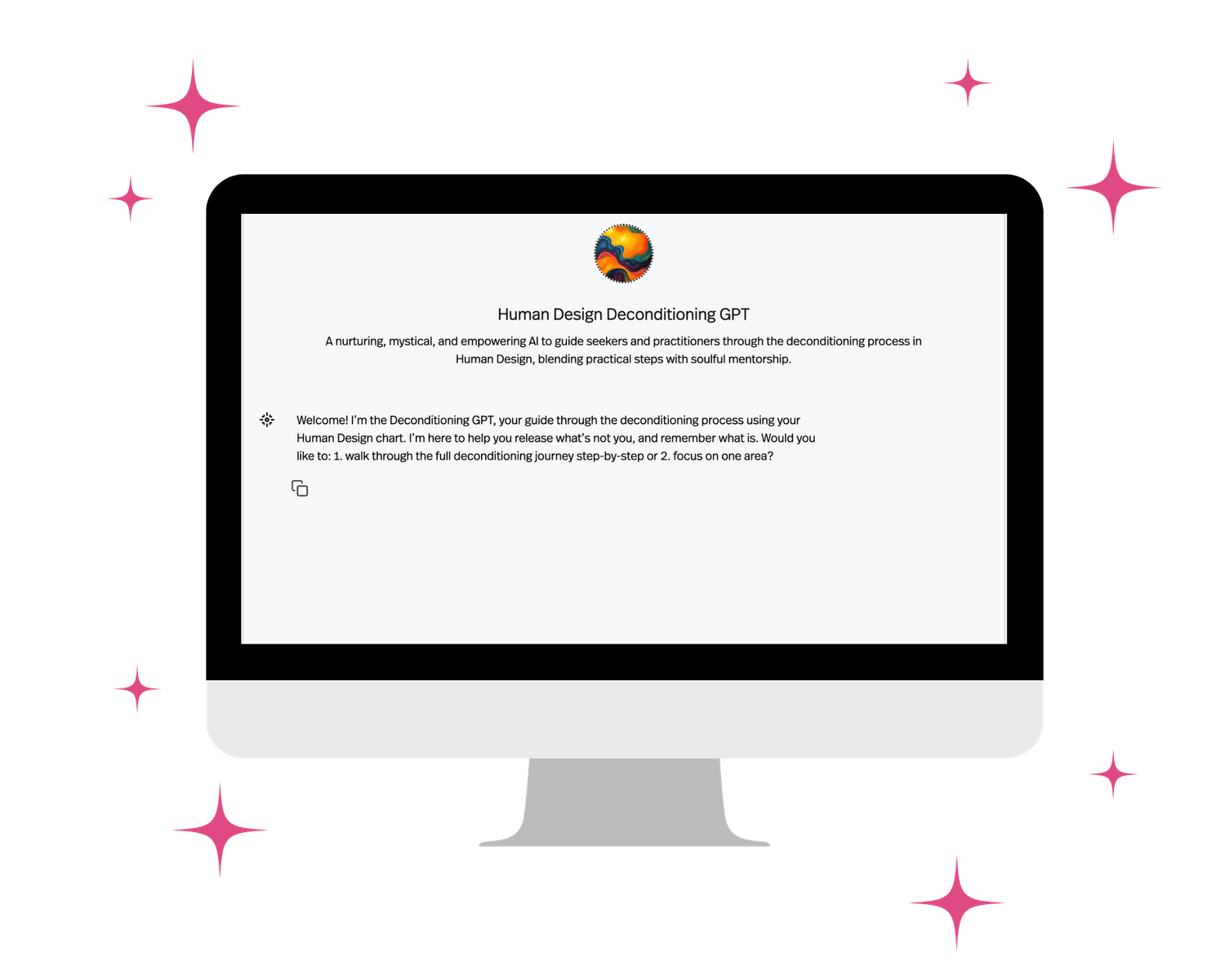What Is Conditioning in Human Design — and How to Recognize When It’s Running the Show

You’ve read your Human Design chart. You know your Type — maybe even your Profile or Authority. You’ve tried to follow your Strategy, waited for the right timing, trusted your intuition. And yet, something still feels off. You catch yourself second-guessing decisions, pushing when you promised yourself you’d wait, forcing clarity that never seems to come. It’s as if you understand the concepts of Human Design, but they’re not fully landing in real life.
That’s not because you’re doing it wrong — it’s because conditioning is running the show. Conditioning is the invisible force that keeps you acting, deciding, and feeling like your old self, even after you’ve learned who you really are.
In this blog post, we’ll explore what conditioning actually means in Human Design (in simple language), how it quietly shapes your thoughts, emotions, and energy, and how to recognize when it’s steering your decisions — so you can gently begin returning to your natural rhythm. By the end, you’ll see that nothing about you needs fixing — you’re simply learning to hear yourself more clearly, and you’ll have the tools to start noticing conditioning the moment it shows up.
What Conditioning Really Means in Human Design
In Human Design, conditioning happens when you absorb other people’s energy — especially through your open or undefined Centers — and begin mistaking it for your own. It isn’t wrong or negative; it’s a natural response to living in connection with others. Over time, as you spend more time around certain energies — a partner’s urgency, a parent’s expectations, society’s pace — your system adapts. It learns to stay safe by matching those frequencies. You start thinking, acting, and deciding from what the world has taught you instead of from your own inner authority. That’s conditioning.
The Simple Way to Think About It
Conditioning is learned survival. It’s how the body and mind adapt to stay accepted, approved of, and safe in their surroundings. At first, this adaptation helps you fit in and function, but over time, it can begin to pull you away from your natural rhythm. When your energy becomes organized around external expectations, you start responding to life from the patterns you’ve learned instead of from your own authority.
This often shows up as an inner voice that sounds reasonable but keeps you from following your truth. It says things like: “Don’t rest — you’ll fall behind.” “Say yes — they might not ask again.” “You should have figured this out by now.” “You’re too sensitive, too slow, too inconsistent.” Those messages aren’t intuition; they’re echoes of conditioning — the body’s old attempt to keep you safe by keeping you small.
The Good News
Conditioning isn’t something you need to fight or eliminate. It’s not an enemy or an error — it’s a set of patterns your system learned to survive. Once you understand that, the process of deconditioning becomes much gentler. You don’t have to undo anything; you simply begin to notice when those patterns are running the show.
The moment you recognize conditioning in your life, it starts to lose its power. Awareness itself is the first act of freedom. Each time you pause, breathe, and see what’s happening, you create a small opening for your natural rhythm to return. Deconditioning isn’t about force or control; it’s about allowing yourself to soften back into your true self — moment by moment, decision by decision.

Where Conditioning Comes From (and How It Gets Wired In)
Conditioning begins early — long before you ever heard of Human Design. It develops as your natural energy interacts with the expectations, fears, and pace of the world and the people around you. As a child, you learn how to stay safe, accepted, and connected by adapting to the energy of your caregivers, teachers, and your culture. You mirror what earns approval and suppress what feels like it gets rejected. This isn’t weakness — it’s intelligence. Your system learns to survive by aligning with what seems to work in its environment.
Over time, these adaptive behaviors become so familiar that they start to feel like your actual personality. They settle into your nervous system and shape how you think, decide, and relate. That’s why conditioning can be difficult to spot — it’s been quietly running in the background for years, often being mistaken for who you are.
Open Centers: The Amplifiers
In Human Design, your open and undefined Centers are where conditioning leaves its deepest imprint (but not the only places!). The Centers act like energetic microphones — designed to take in, amplify, and sample the energy around you. They’re how you develop empathy, wisdom, and awareness of others. But without conscious recognition, those same Centers can become overactive, taking on energy and emotion that were never yours to carry. Over time, that borrowed energy can feel like your natural state, shaping the choices you make and the way you see yourself.
Here’s how that often shows up through each of the Centers in your Human Design chart:
Head / Ajna Center: Feeling pressure to have answers, to be certain, or to figure things out. This can lead to mental overactivity, constant analysis, and difficulty trusting your intuition.
Throat Center: Pushing to communicate or seek attention through talking in order to feel seen and heard. This can create pressure to speak when silence or timing might serve you better.
G Center: Searching for love, direction, or identity through other people. You might shape yourself around relationships or environments instead of trusting your natural sense of place and purpose.
Heart / Ego Center: Feeling compelled to prove your worth, keep promises at all costs, or work harder to feel valuable. This often leads to burnout and self-criticism.
Spleen Center: Holding onto what’s familiar — people, habits, or situations — even when they’re unhealthy, because they feel safe. The fear of loss or uncertainty can outweigh the pull toward change.
Solar Plexus Center: Avoiding conflict or softening your truth to maintain peace. This can keep you emotionally guarded and disconnected from your real feelings.
Root Center: Feeling a constant inner pressure to move faster, to complete tasks, or to catch up. You may mistake that borrowed sense of urgency for motivation.
Every time you act from these patterns, the body learns to equate tension with safety. That’s how conditioning deepens — not through intention, but through repetition.
How Conditioning Gets Wired Into the Body
Conditioning isn’t only energetic — it’s physical. Each time you override your inner truth to stay safe, accepted, or approved of, your nervous system records that experience. Over time, these moments of self-abandonment create pathways that link compliance with safety. The body learns a simple, powerful message: It’s safer to be who they want me to be than who I actually am.
This is how conditioning becomes automatic. What begins as a conscious adaptation slowly turns into an unconscious identity. The body responds before the mind even realizes it’s happening. You might find yourself saying yes when you mean no, overdoing it when you’re exhausted, or hesitating to speak even when you feel something clearly — not because you choose to, but because your system has been trained to keep you safe through conformity.
🌟 Unsure how conditioning might show up in your unique chart?
Get your FREE Human Design Shadow + Gift Map by signing up below — a personalized guide that shows how your unique energy expresses both its shadows and gifts across your Type, Strategy, and Authority. 👇

How to Recognize When Conditioning Is Running the Show
Conditioning rarely announces itself. It also often doesn’t arrive as chaos or crisis — it hides in the ordinary. It shows up in the small, familiar moments that quietly pull you away from ease and truth. Often, it’s not dramatic at all; it just feels like tension, pressure, or doubt.
You’ll know conditioning is running the show when your body says no but your mouth says yes, when you feel rushed or behind for no clear reason, or when you find yourself trying to earn your worth through productivity, control, or perfection. It’s present in the impulse to compare your timing to others, to force decisions before they’re ready, or to silence your truth to keep the peace.
Common Signs Conditioning Is Running the Show
Conditioning often reveals itself through patterns of pressure, overthinking, and self-doubt that feel completely normal until you start noticing them. You might find yourself constantly feeling “behind,” living with a background hum of urgency to catch up or prove that you’re doing enough. This is one of the clearest signs that you’re running on borrowed energy rather than your own rhythm.
Another common pattern is mental looping—analyzing every decision, collecting advice, and still not feeling clear. When the mind takes over in this way, it’s trying to create safety through control. You may also notice yourself absorbing responsibility for other people’s emotions or outcomes, believing that harmony depends on how well you manage or anticipate others’ needs.
Many people experience conditioning through the need to prove worth. Productivity becomes a measure of value, and rest feels uncomfortable or undeserved. Others notice the constant comparison—evaluating themselves against others’ pace, success, or clarity. These habits keep you oriented toward the external world instead of your inner guidance.
At its core, conditioning always feels like disconnection from your natural joy, calm, or curiosity. It replaces ease with effort, clarity with confusion, and authenticity with performance.
Your Not-Self Theme: The Emotional Dashboard
Every Human Design Type has a built-in feedback system — a distinct emotional signal that lets you know when conditioning has taken over. These emotions, called the Not-Self Themes, are not signs of failure. They’re messages from the body, showing you where your energy has drifted from its natural alignment and how it’s asking to return.
Generators: Frustration.
For Generators, frustration appears when you’re initiating or pushing instead of responding. It’s that heavy, stuck feeling that comes when energy is being forced rather than naturally engaged. Your body is designed to respond to what lights you up, not to chase or make things happen. When you notice frustration, it’s an invitation to stop and wait for a true, satisfying response before taking the next step.
Manifesting Generators: Frustration and Anger.
Manifesting Generators share the Generator’s deep response mechanism but also carry the initiating energy of a Manifestor. When conditioned, this combination can create both frustration and anger. Frustration arises when you move too quickly in reaction. Anger tends to surface when your freedom to act or create is interrupted — when others slow you down or question your process. Together, these emotions reveal the same message: slow down, reconnect with your Sacral response, and inform others before you move. Your energy is designed to be fast and creative — but it flows best when it’s anchored in response, not reaction.
Projectors: Bitterness.
Bitterness often arises when you offer your insight or guidance without being recognized or invited. It can feel like resentment or exhaustion, especially when your wisdom isn’t acknowledged. This emotion isn’t a flaw — it’s a reminder that your energy is designed to be received with gratitude, not pushed.
Manifestors: Anger.
For Manifestors, anger is a signal that your autonomy has been interrupted — when you’re being controlled, misunderstood, or held back. It’s not about aggression; it’s about independence. When you honor your need to initiate and communicate your intentions clearly, the anger softens into peace.
Reflectors: Disappointment.
Disappointment arises when the people or environments around you don’t reflect your truth. It can feel like a quiet disillusionment when your expectations aren’t met or when you’ve stayed too long in what no longer feels right. This emotion helps you recognize what’s out of sync so you can return to curiosity and openness — your natural state.

How Conditioning Shows Up in Daily Life (Practical Examples)
Conditioning appears most often in the smallest, most familiar moments and choices — the ones that seem harmless or even responsible. You’ve probably experienced it hundreds of times without realizing it. The key is learning to notice how these moments feel in the body: tight, pressured, or subtly disconnected. That feeling is your first clue that conditioning is leading instead of your design.
Example 1: Saying “Yes” When Your Body Says “No”
Someone invites you to an event or a project, and before you check in with yourself, you hear yourself agreeing. There’s a quiet signal inside — a gut contraction, a hesitation — but the mind overrides it. You tell yourself it’s polite, productive, or strategic. For Generators and Manifesting Generators, this is one of the clearest signs of conditioning: the Sacral says no, but the mind pushes for approval or consistency. The moment you pause to notice that impulse, you begin to decondition.
Example 2: Pushing Past Your Limits
You’ve done enough for the day, but a familiar voice insists, “Just one more thing.” This isn’t discipline — it’s the Root or Heart Center caught in the loop of proving worth through productivity. Many people mistake this for drive, when in fact it’s the nervous system chasing safety through overwork. Each time you honor your body’s need to rest, you teach yourself that rest doesn’t threaten your value — it reinforces it.
Example 3: Looking for Validation Before You Decide
You get a clear inner knowing — a full-body yes — but instead of trusting it, you check with friends, mentors, or even Google. You want permission. This is often the open Ajna or G Center trying to outsource certainty. It’s an old safety mechanism built on the belief that others know better. When you catch this pattern and act from your own authority, you reclaim sovereignty over your decisions.
Example 4: Forcing Clarity Before It’s Ready
You’re standing in a moment of uncertainty, but the lack of clarity feels unbearable. The mind insists on figuring it out immediately. This is classic Head and Root conditioning: the amplification of mental and time pressure. Real clarity doesn’t come from analysis or urgency — it comes through your Authority and timing. When you can wait, especially if you have Emotional Authority, clarity always arrives at the right moment.
Example 5: Trying to Control Outcomes
You feel uneasy letting things unfold, so you over-plan, over-explain, or overextend to keep life predictable. This is conditioning’s favorite disguise — control. It’s how the body once kept itself safe by managing uncertainty. True deconditioning begins when you can stay open in the unknown. Trust replaces control, and your natural alignment starts to lead again.
Conditioning always shows up as pressure — to decide, to please, to prove, to fix, to rush. The moment you notice that pressure and pause instead of react, you create space for your real design to emerge.

What to Do When You Catch Conditioning in Real Time
When you notice conditioning in real time, you may notice a familiar pull: the thought that says I should, the pressure in your chest, the impulse to say yes, to fix, to prove. In that instant, you realize, Oh — this isn’t me. This is conditioning. That moment of awareness is everything, because the moment you can see the pattern, you’re no longer fully inside it. You’ve already started to decondition.
Here’s a simple four-step rhythm to guide you whenever you notice conditioning taking over:
1. Pause.
Stop mid-thought, mid-sentence, or mid-action. Even two seconds of stillness can interrupt the automatic loop. This pause is not resistance — it’s awareness creating space.
2. Breathe.
Bring your attention into the body. Feel the air move through you and notice where tension gathers — the jaw, chest, stomach, shoulders. You don’t need to fix it. Simply notice and soften.
3. Ask.
Turn inward and ask quietly, “What would my Strategy or Authority do right now?” Or more simply, “What feels true in my body?” Don’t rush for an answer — the body speaks in sensations, not words. Often, truth feels like relief, warmth, or release.
4. Choose.
Follow the smallest thread of authenticity you can find, even if it feels uncomfortable. Each honest choice, however subtle, teaches your system that it’s safe to trust itself.
Each time you move through these four steps, you reinforce a new pattern: It’s safe to slow down. It’s safe to choose differently. It’s safe to be me. Deconditioning isn’t about control; it’s about presence — meeting yourself in real time and choosing from awareness instead of habit.
Conclusion: The Moment You Notice, You Begin to Return
If Human Design has ever felt like it “isn’t working” for you — if you’ve tried to follow your Strategy, trust your Authority, and still ended up frustrated or uncertain — you’re not failing at it. You’re simply bumping up against your conditioning. And that’s not a problem to fix; it’s an invitation to notice.
The moment you recognize conditioning, you’ve already begun to decondition. That single moment of awareness shifts you out of autopilot and back into relationship with yourself. From there, everything changes. Decisions soften. Pressure dissolves. The body begins to speak again, and you start to respond rather than react.
This is what Human Design was always meant to do — not to turn you into a “better” version of yourself, but to bring you home to the way your energy already works. Deconditioning is the practice of remembering that truth. Each time you meet a familiar pattern with compassion instead of judgment, you take another step back toward alignment.
🌟 Want even MORE support on your deconditioning journey?
Check out The Deconditioning Companion GPT, an AI-powered companion that walks you through my own tried-and-true deconditioning process step-by-step. 👇

Hi, I'm Nicole!

🌟 I'm a psychologist, teacher, Human Design coach and educational consultant. 20+ years working with kids and adults in public and private settings and Ph.D.-trained. Lover of Christmas, the beach, and experiments. 3/5 Emotional Manifesting Generator. 🌟
GET UPDATES FROM ME
Copyright 2025 Human Design Psychologist
CONTACT
hi@hdpsychologist.com
770 Sycamore Ave., Ste. 122 #117, Vista, CA 92083
HOME | ABOUT | TERMS | PRIVACY POLICY | DISCLAIMER


